 Have you been told you are not Pitching with Your Lower Half? Then this is a must read for you!
Have you been told you are not Pitching with Your Lower Half? Then this is a must read for you!
Baseball pitching is a complex athletic talent that combines strength, accuracy, and biomechanical efficiency to attain optimal performance. This article explores the biomechanics of force generation, an important principle of pitching that has a considerable impact on the performance and injury potential of baseball pitchers. In this application, force generation refers to the pitcher's ability to generate forces throughout the pitching sequence, efficiently employing muscular power and kinetic energy to optimize ball velocity and control while limiting the risk of injury.
The effectiveness of pitching is based on a series of intricate biomechanical concepts that coordinate the dynamic exchange of forces throughout different parts of the body. The fundamental concept of the kinetic chain principle, which is crucial for understanding pitching mechanics, highlights the sequential activation and transmission of energy from the lower limbs and hips, passing through the torso, and ultimately reaching the arm (Seroyer et al., 2010). Mastering these biomechanical processes is crucial for maximizing pitch velocity and precision and serves as the foundation for preventive measures against common pitching injuries.
Extensive research highlights the crucial importance of ground reaction forces (GRF) and energy flow (EF) in the biomechanics of pitching. The GRF, which are the forces exerted by the ground in response to the pitcher's motions, are essential for generating the initial kinetic energy that is necessary for the latter stages of the throwing motion (MacWilliams et al., 1998). The transfer and manipulation of energy, known as EF, are essential for the proper transmission of kinetic energy along the kinetic chain, from the initial stance of the lower body to the final release of the baseball.
The study conducted by Howenstein, Kipp, and Sabick (2020) has extensively investigated the relationship between GRF and EF in young pitchers. This research has produced valuable insights into the interplay of these forces, which can improve pitching efficiency and mitigate the risk of injuries. The studies often demonstrate the correlation between peak GRF, specifically those generated by the drive leg, and the EF that influences various movements throughout the pitching motion. This impact affects overall performance and the mechanical stress on specific joints (McNally et al., 2015).
This research seeks to enhance and build upon the current understanding by thoroughly examining the literature on the biomechanical principles of generating force in baseball pitching, particularly emphasizing the significance of GRF and EF. This examination aims to clarify the intricate biomechanical interactions involved in good pitching and suggest practical ideas to improve performance and reduce the likelihood of injuries.
Biomechanical Analysis of Pitching with Your Lower Half
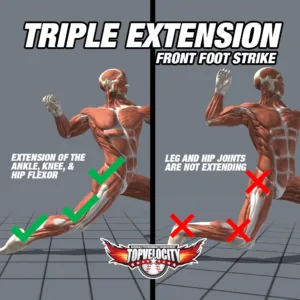 Baseball pitching is a complex and dynamic movement that involves the coordination of several body parts to generate and transfer forces from the pitcher to the baseball. The biomechanics of this action can be explained by the concept of the kinetic chain, which involves a sequential and coordinated movement of body parts. This movement starts from the lower body, passes through the trunk, and finally extends through the arm to release the baseball at high velocities (Seroyer et al., 2010).
Baseball pitching is a complex and dynamic movement that involves the coordination of several body parts to generate and transfer forces from the pitcher to the baseball. The biomechanics of this action can be explained by the concept of the kinetic chain, which involves a sequential and coordinated movement of body parts. This movement starts from the lower body, passes through the trunk, and finally extends through the arm to release the baseball at high velocities (Seroyer et al., 2010).
The kinetic chain starts with the leg lift when pitching, during which the pitcher initiates the movement that triggers the motion of the body. This phase is called the stride phase and is crucial for establishing the sequential and coordinated movement of body parts to power the pitching delivery. The process of generating force begins in the feet and moves into the legs, specifically when the pitcher propels himself off the pitching rubber with the back leg. This motion creates GRFs that play a vital role in the pitcher's subsequent actions (Fleisig et al., 1995). This force generated by the legs is transmitted vertically along the kinetic chain, passing through the pelvis, trunk, and finally the shoulders. This is a crucial process for effective EF and achieving the highest possible velocity (Pryhoda, & Sabick, 2022).
The significance of Pitching with Your Lower Half cannot be exaggerated; it acts as the base for generating force and maintaining stability during the pitching motion. The propulsion of the body begins with the drive leg, which generates the initial force that is then magnified as it travels upwards through the body (Stodden et al., 2001). The lower body not only generates force but also plays a crucial function in stabilizing the entire body during the release of the pitch. This is apparent in the movements of the leg muscles and the hip joint during the release of the ball. The hips have a crucial function in producing rotational speed and transmitting this force from the trunk to the upper body (Seroyer et al., 2010).
During the stride phase of the pitch, the front leg contacts the ground and stabilizes the lower body, creating a stable foundation for the rotation of the pelvis and trunk. This movement is important because it enables the upper body to spin rapidly while still retaining control and direction (Kageyama et al., 2014). Ensuring the coordination of pelvic rotation with trunk rotation is of utmost importance. Any deviation in the timing of pelvic rotation, whether it occurs too early or too late, can have a detrimental effect on the entire kinetic chain. This can potentially lead to a decrease in pitch velocity and accuracy, while also increasing the likelihood of sustaining an injury (Stodden et al., 2001).
Furthermore, the effective utilization of the lower extremities influences the precise timing of muscle activation during the pitching motion. As the energy ascends, the muscles in the trunk and shoulders are activated to sustain the process of transferring energy, resulting in a final surge of velocity as the arm propels forward to release the ball. The accurate synchronization of these movements guarantees that the ball receives the highest amount of energy at the moment of ball release (Fleisig et al., 1999).
Ground Reaction Forces and Pitching with Your Lower Half
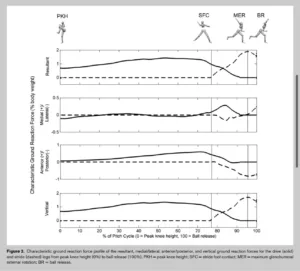 GRFs are crucial in the biomechanics of baseball pitching, as they are a critical principle of the kinetic chain that converts lower body power into pitching performance. These forces not only measure the power created by the pitcher but also form the basis for the transfer of kinetic energy up through the pitcher's body (Liu et al., 2023).
GRFs are crucial in the biomechanics of baseball pitching, as they are a critical principle of the kinetic chain that converts lower body power into pitching performance. These forces not only measure the power created by the pitcher but also form the basis for the transfer of kinetic energy up through the pitcher's body (Liu et al., 2023).
An important factor in pitching is the distinction between the drive leg (back leg) and stride leg (front leg) in the generation of GRF. The drive leg is responsible for generating the initial force in the delivery and early cocking phases of the upper body, mainly contributing to the vertical and propulsive forces. The movement of this leg is vital for initiating the series of movements that result in high velocities of the ball (Oyama & Myers, 2018). On the other hand, the leg that ends the stride is responsible for applying braking forces that help the pitcher maintain stability upon landing. This enables effective transfer of energy throughout the crucial stages of arm cocking and ball release (Nicholson et al., 2021).
Research, such as the one conducted by Howenstein et al. (2020), has presented empirical evidence demonstrating the direct correlation between these GRF components and pitching mechanics. They disclosed that the maximum propulsive forces generated by the drive leg are strongly associated with improved EF across the body's segments, particularly into the pelvis and trunk. These areas are essential for maintaining balance and attaining adequate trunk rotation during the pitch.
The interaction between GRF and EF between the pelvis, trunk, and arm segments has important consequences for both pitching performance and injury prevention. EF, which explains the distribution and utilization of energy in various body parts, is essential for understanding the biomechanics of throwing. The transfer of force from the lower body to the upper body segments, which is initiated by strong GRFs, can improve the mechanical efficiency and velocity of the pitch while decreasing the strain on the arm. This helps to reduce the risk of injuries (Mathews et al., 2019).
Research has demonstrated that an increase in propulsive GRF generated by the drive leg is associated with a higher amount of EF into the pelvis and trunk. This link is crucial because it highlights the impact of lower body mechanics on the throwing mechanics of the upper body. Optimizing EF across these segments can result in increased pitch velocities and less strain on the arm, namely the elbow and shoulder, which are frequent sites of injury in pitchers (Kageyama et al., 2014).
In addition, the braking forces exerted by the landing leg also have a substantial impact. These forces contribute to the stabilization of the pitcher's landing and create the conditions for the upper body to efficiently harness the energy supplied when Pitching with Your Lower Half. Optimizing the braking force in a balanced and timely manner might result in improved energy economy and control, enabling the pitcher to sustain a consistent performance while minimizing the chances of becoming injured (Guido & Werner, 2012).
Ultimately, the thorough examination of GRF and their influence on EF in the pelvis, trunk, and arm segments offers valuable understanding of the biomechanical optimization of baseball pitching. By understanding and improving these fundamental elements of pitching mechanics, coaches and trainers can more effectively create training programs that optimize performance and mitigate injuries, therefore prolonging the careers of pitchers.
Energy Flow in Pitching with Your Lower Half
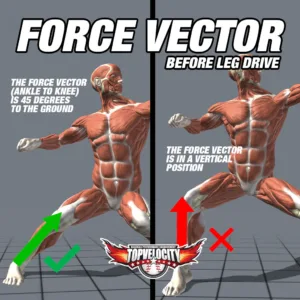 EF in pitching mechanics is the measurement of energy transmitted between various body segments during a pitch. Understanding this concept is crucial for comprehending the pitcher's effective utilization of mechanical energy from the beginning of the pitching motion until the ball is released. EF is determined by integrating the power transfer, in both directions, for each segment of the body during the pitching action (Howenstein et al., 2018). This formula quantifies the process of how energy is produced when Pitching with Your Lower Half, transmitted through the trunk, and delivered by the arm, ultimately affecting both the speed of the pitch and the mechanical stress encountered by the pitcher.
EF in pitching mechanics is the measurement of energy transmitted between various body segments during a pitch. Understanding this concept is crucial for comprehending the pitcher's effective utilization of mechanical energy from the beginning of the pitching motion until the ball is released. EF is determined by integrating the power transfer, in both directions, for each segment of the body during the pitching action (Howenstein et al., 2018). This formula quantifies the process of how energy is produced when Pitching with Your Lower Half, transmitted through the trunk, and delivered by the arm, ultimately affecting both the speed of the pitch and the mechanical stress encountered by the pitcher.
Efficient pitching mechanics rely on the crucial transmission of energy when Pitching with Your Lower Half, through the trunk, to the arm. At first, energy is produced in the lower limbs, beginning with the drive leg exerting force on the ground, resulting in significant GRF. This force initiates the production of kinetic energy, which in turn triggers the sequential process required for pitching. As the pitcher propels forward, the energy is transmitted sequentially along the kinetic chain: initially to the pelvis rotation, then to the trunk rotation, and ultimately the rotation of extension of the upper body.
The pelvis serves as a crucial link between the creation of energy when Pitching with Your Lower Half and its transmission to the upper body. Correct pelvic rotation is essential as it signifies the initial shift of energy from linear movements in the lower body to the rotational movements that predominate in the upper body throughout a pitch. The core, also known as the trunk, enhances the energy by utilizing rotational and flexion/extension movements, efficiently transmitting the stored energy to the shoulder complex (Howenstein et al., 2018).
Joint Force Power (JFP) and Joint Moment Power (JMP) are essential measures for evaluating the application of forces and torques at different joints during the pitching action. These measures directly impact the transmission and utilization of energy. JFP measures the rate at which work is performed by combined forces acting on the proximal and distal ends of body segments. This contributes to the linear component of segment power. On the other hand, JMP, which is caused by muscle forces, mostly contributes to the rotational part of segment power. Both measures are essential for understanding the individual contributions of segments to the total energy transfer in pitching mechanics.
During a pitch, the drive leg starts the motion and the JFP mostly contributes to creating linear force that starts the kinetic chain. As the motion advances and shifts from straight-line to circular movements, the role of JMP becomes more important, especially in the trunk and arm. JMP helps convert linear momentum into rotational energy, which is crucial for obtaining high pitch velocities (Howenstein et al., 2020).
The efficient flow of energy, supported by both JFP and JMP, is maximized in a highly coordinated pitch. This optimization enables effective transmission of high-energy, resulting in maximum energy delivery to the ball while minimizing energy waste caused by inefficient mechanics or excessive joint loads. Furthermore, examining these elements aids in the detection of biomechanical deficiencies or other factors that increase the risk of injury, especially in the heavily strained joints of the shoulder and elbow.
To effectively diagnose and improve pitching effectiveness, it is crucial to have a comprehensive understanding and evaluation of EF, JFP, and JMP. Through the analysis of energy generation, transfer, and utilization across the kinetic chain, coaches and biomechanists may create training and rehabilitation programs that enhance performance and reduce the likelihood of injury.
Empirical Evidence and Case Studies on Pitching with Your Lower Half
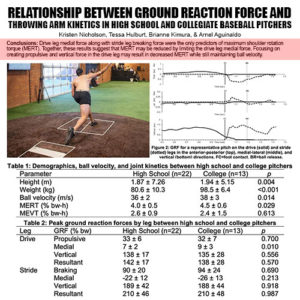 Empirical research on young pitchers offers crucial understanding of the biomechanical mechanics of baseball pitching, with a specific emphasis on the substantial contributions of GRF, joint torques, and EF within the kinetic chain. Sakurai et al., (2023) reviewed evidence suggesting the crucial function of lower extremity mechanics in transmitting energy from the lower limbs to the throwing arm, thereby impacting ball velocity and pitcher performance.
Empirical research on young pitchers offers crucial understanding of the biomechanical mechanics of baseball pitching, with a specific emphasis on the substantial contributions of GRF, joint torques, and EF within the kinetic chain. Sakurai et al., (2023) reviewed evidence suggesting the crucial function of lower extremity mechanics in transmitting energy from the lower limbs to the throwing arm, thereby impacting ball velocity and pitcher performance.
In addition, a study conducted by Ramsey and Crotin (2019) investigated the influence of stride length on the forces involved in propelling and stabilizing the body during overhand throwing. The research findings suggest that changes in stride length have a major impact on GRF patterns, which subsequently affect the kinetics of joint reactions and the velocity of the ball.
Collecting empirical data can greatly improve the performance of young pitchers and reduce the chances of damage. An understanding of the connection between stride length and GRF can assist coaches and trainers in creating training programs that focus on achieving the most effective stride length and body positioning to enhance propulsive forces and maintain stability during the pitch (Ramsey & Crotin, 2019).
These findings are also crucially applicable in the field of injury prevention. Research indicates that incorrect usage of the kinetic chain and insufficient or excessive GRF might cause heightened strain on the joints and muscles of the arm, which may lead to overuse injuries. By combining information on efficient EF and the dynamics of joint torque, training regimens may be customized to strengthen the specific muscles involved and improve mechanical efficiency. This, in turn, reduces the chance of injury.l
Furthermore, these studies provide a more profound understanding of the exertion of forces and moments at different joints during the pitching motion, through the examination of JFP and JMP. This understanding enables the creation of focused modalities that target biomechanical inefficiencies and assist pitchers in maintaining a healthier and more sustainable pitching delivery.
Conclusion
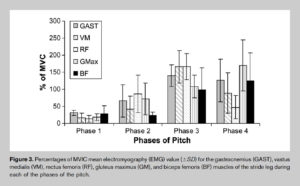 This paper has thoroughly examined the biomechanical principles that constitute the foundation of baseball pitching. It has clarified the crucial role these principles play in improving performance and minimizing the risk of injury. The provided analyses have explored the complexities of GRF and EF, highlighting their crucial roles in efficient pitching mechanics.
This paper has thoroughly examined the biomechanical principles that constitute the foundation of baseball pitching. It has clarified the crucial role these principles play in improving performance and minimizing the risk of injury. The provided analyses have explored the complexities of GRF and EF, highlighting their crucial roles in efficient pitching mechanics.
These biomechanical principles have practical implications that greatly impact the training and rehabilitation routines for pitchers, rather than being just academic. A detailed understanding of GRF is beneficial for developing exercises that optimize the efficient transmission of energy from the lower body, throughout the kinetic chain, to the pitching arm. Moreover, a better understanding of the dynamics of EF enables the creation of focused interventions that aim to enhance energy economy during the pitching motion. This, in turn, improves performance and reduces the risk of injuries caused by excessive mechanical loads.
There are several intriguing paths for future research in pitching biomechanics that have the potential to provide significant gains. Longitudinal studies are necessary to monitor the progress of pitchers from their early years to their professional careers. These studies will provide valuable insights into the evolution of biomechanical efficiency and how they might be maximized at each stage of an athlete's growth. In addition, the incorporation of wearable technology to consistently monitor pitchers during games and training sessions could offer instantaneous data, enabling prompt modifications and customized training plans.
Another promising research direction would be to further investigate the biomechanical disparities in pitching approaches among various types of pitches (such as fastball, curveball, slider) and their effects on GRF and EF. This research could assist in customizing specialized training programs that concentrate on the distinct requirements of each pitch type.
Furthermore, the influence of fatigue on the mechanics of pitching is still a relatively unexplored field. Gaining insight into the breakdown of a pitcher's mechanics during a game or season could result in improved management techniques that reduce performance declines and mitigate the likelihood of injuries caused by fatigue.
To close, the discipline of sports biomechanics provides numerous prospects for both advancing our scientific understanding and utilizing this information in practical ways to improve athletic performance and protect athletes' health. The continuous collaboration among researchers, coaches, and medical specialists is crucial to further advance the limits of what can be achieved in Pitching with Your Lower Half.
Reference
Fleisig, G. S., Andrews, J. R., Dillman, C. J., & Escamilla, R. F. (1995). Kinetics of baseball pitching with implications about injury mechanisms. The American journal of sports medicine, 23(2), 233-239.
Fleisig, G. S., Barrentine, S. W., Zheng, N., Escamilla, R. F., & Andrews, J. R. (1999). Kinematic and kinetic comparison of baseball pitching among various levels of development. Journal of biomechanics, 32(12), 1371-1375.
Guido Jr, J. A., & Werner, S. L. (2012). Lower-extremity ground reaction forces in collegiate baseball pitchers. The Journal of Strength & Conditioning Research, 26(7), 1782-1785.
Howenstein, J., Kipp, K., & Sabick, M. (2020). Peak horizontal ground reaction forces and impulse correlate with segmental energy flow in youth baseball pitchers. Journal of Biomechanics, 108, 109909.
Howenstein, J., Kipp, K., & Sabick, M. B. (2018). Energy flow analysis to investigate youth pitching velocity and efficiency. Medicine & Science in Sports & Exercise.
Kageyama, M., Sugiyama, T., Takai, Y., Kanehisa, H., & Maeda, A. (2014). Kinematic and kinetic profiles of trunk and lower limbs during baseball pitching in collegiate pitchers. Journal of sports science & medicine, 13(4), 742.
Liu, J. M., Knowlton, C., Gauthier, M., Tropp, Z., Verma, N., Nicholson, G., ... & Zaferiou, A. (2023). Roles of each leg in impulse generation in professional baseball pitchers: Preliminary findings uncover the contribution of the back leg towards whole-body rotation. Sports Biomechanics, 1-16.
MacWilliams, B. A., Choi, T., Perezous, M. K., Chao, E. Y., & McFarland, E. G. (1998). Characteristic ground-reaction forces in baseball pitching. The American journal of sports medicine, 26(1), 66-71.
Mathews, J. (2019). Drive and Stride Leg Kinetics and Kinematics in Adolescent Baseball Pitchers with Lower Extremity-Dominant and Upper Extremity-Dominant Pitching Styles (Doctoral dissertation, Saint Louis University).
McNally, M. P., Borstad, J. D., Oñate, J. A., & Chaudhari, A. M. (2015). Stride leg ground reaction forces predict throwing velocity in adult recreational baseball pitchers. The Journal of Strength & Conditioning Research, 29(10), 2708-2715.
Nicholson, K. F., Hulburt, T. C., Kimura, B. M., & Aguinaldo, A. L. (2021). Relationship between ground reaction force and throwing arm kinetics in high school and collegiate pitchers. The Journal of sports medicine and physical fitness, 62(9), 1179-1183.
Oyama, S., & Myers, J. B. (2018). The relationship between the push off ground reaction force and ball speed in high school baseball pitchers. The Journal of Strength & Conditioning Research, 32(5), 1324-1328.
Pryhoda, M. K., & Sabick, M. B. (2022). Lower body energy generation, absorption, and transfer in youth baseball pitchers. Frontiers in Sports and Active Living, 4, 975107.
Ramsey, D. K., & Crotin, R. L. (2019). Stride length: the impact on propulsion and bracing ground reaction force in overhand throwing. Sports Biomechanics, 18(5), 553-570.
Sakurai, M., Szymanski, D. J., Qiao, M., & Crotin, R. L. (2023). Combined Countermovement Jump Testing and Motion Analysis as the Future of Performance Assessment for Baseball Pitchers: A Narrative Review. The Journal of Strength & Conditioning Research, 37(6), 1327-1338.
Seroyer, S. T., Nho, S. J., Bach, B. R., Bush-Joseph, C. A., Nicholson, G. P., & Romeo, A. A. (2010). The kinetic chain in overhand pitching: its potential role for performance enhancement and injury prevention. Sports health, 2(2), 135-146.
Stodden, D. F., Fleisig, G. S., McLean, S. P., Lyman, S. L., & Andrews, J. R. (2001). Relationship of pelvis and upper torso kinematics to pitched baseball velocity. Journal of applied biomechanics, 17(2), 164-172.
For more exclusive content on Pitching with Your Lower Half when you visit TopVelocity Patreon!
Visit the home page to learn more about our training programs and Pitching with Your Lower Half!




Understood is the research on the forces between the legs, trunk, and EF. However, there is no mention of how a pitcher is able to maintain “Balance” and I’m quite sure without balance there is not much EF in the proper direction. Additionally, how and when these forces impact proper arm extension is missing. After all a pitchers arm is attached to the hand holding the ball. I’m sure the study is accurate – I’m just not sure it has anything to do with coaching. Proper balance and arm extension are fundamental principles of pitching.